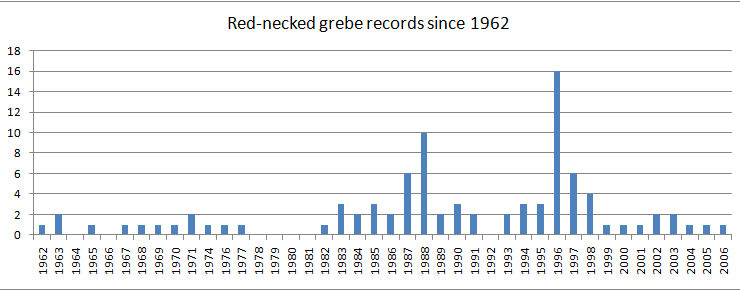Red-necked Grebe
 Tuesday, May 4, 2010 at 6:01PM
Tuesday, May 4, 2010 at 6:01PM Podiceps grisegena
A scarce winter visitor and passage migrant.
The Red – necked Grebe breeds mainly in fresh water habitat, in the temperate Palearctic and Nearctic, mostly wintering on tidal waters.
In Pembrokeshire, Mathew (1894) noted that the Red–necked Grebe had been killed several times at Pembroke Mill Pond. Thereafter records were more specific. A total of 102 birds were recorded in 44 years between 1898 and 2006, observer cover being greatest from the 1980’s. It seems that the species has been a regular visitor but more have been seen in some years than in others, mostly one to four in a year but six were noted in 1987 and 1997, 10 in 1988 and 16 in 1996.
Annual totals on record
 They have been noted around the outer coast at Newport Bay, Fishguard harbour, Solva, Newgale, Druidston, Little and Broad Haven (N), Martin’s Haven, Wooltack Point, St Ann’s Head, Giltar and Tenby, on the Teifi Estuary and in most parts of the extensive Cleddau Estuary as far upstream as Little Milford. They have also occurred on fresh waters at Bosherston, Llys y fran Reservoir, Heathfield Gravel Pit, Pen Beri Reservoir, Treginnis, Slate Mill Reservoir, Bicton Reservoir, Westfield Pill and Crickmarren Pond. Additionally singles were recorded once at Skomer, twice at Skokholm and on six occasions flying past Strumble Head, which were considered to be active migrants.
They have been noted around the outer coast at Newport Bay, Fishguard harbour, Solva, Newgale, Druidston, Little and Broad Haven (N), Martin’s Haven, Wooltack Point, St Ann’s Head, Giltar and Tenby, on the Teifi Estuary and in most parts of the extensive Cleddau Estuary as far upstream as Little Milford. They have also occurred on fresh waters at Bosherston, Llys y fran Reservoir, Heathfield Gravel Pit, Pen Beri Reservoir, Treginnis, Slate Mill Reservoir, Bicton Reservoir, Westfield Pill and Crickmarren Pond. Additionally singles were recorded once at Skomer, twice at Skokholm and on six occasions flying past Strumble Head, which were considered to be active migrants.
They were mainly recorded in the periods of January to March, 55 %, and October to December, 40 %, but also seen four times in April, once in May (at Skokholm on the 21st 1997), once in July (at Dale on the 30th 1948) and six times in September.
Graham Rees
( Covers records up to and including 2006 ).
 GHR,
GHR,  grebe,
grebe,  migration,
migration,  winter in
winter in  Red-necked Grebe
Red-necked Grebe 

Reader Comments